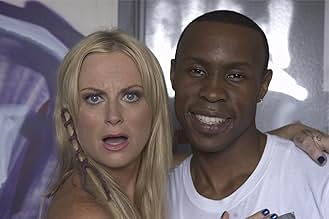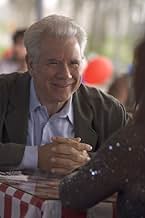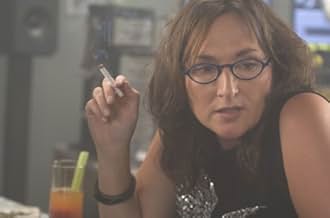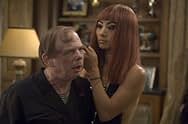Au cours d'une canicule de trois jours juste avant la grande fête du 4 juillet, une star amnésique rencontre une star du porno qui développe son propre projet de télé-réalité, et un policier... Tout lireAu cours d'une canicule de trois jours juste avant la grande fête du 4 juillet, une star amnésique rencontre une star du porno qui développe son propre projet de télé-réalité, et un policier qui détient la clé d'un vaste complot.Au cours d'une canicule de trois jours juste avant la grande fête du 4 juillet, une star amnésique rencontre une star du porno qui développe son propre projet de télé-réalité, et un policier qui détient la clé d'un vaste complot.
- Réalisation
- Scénario
- Casting principal
- Récompenses
- 1 victoire et 3 nominations au total
- UPU 4 Officer 3
- (as Chris Ciulla)
Avis à la une
Richard Kelly's DONNIE DARKO, while clearly the work of a not-yet-matured filmmaker, gave us the promise of a budding artist whose intentions might have been similar to those aforementioned filmmakers. Unfortunately, after seeing his follow-up, SOUTHLAND TALES, I believe his potential has either been stilted, stalled, or misperceived. In fact, viewing TALES and DARKO back-to-back, his second film comes across as utter regression.
TALES felt like the longest, most expensive student film I've ever seen. At just under three hours, it's a sprawling mess. Oddball for the sake of being oddball, cryptic for the sake of of being cryptic, tonally confused, structurally struggling, I think, no matter how they "clean it up," it will be impossible to salvage.
There's nothing on screen to make you care. To make you invested. There are no stakes. Actually, there's no plot, just a bunch of incidents which are all happening at the same time seemingly to justify why these characters would criss-cross. The characters are so thinly conceived, you find yourself looking at the scenery (all in LA), trying to name the street, beach, or building. The imagery is repetitive and banal. The themes are jumbled and stated over and over again by on-the-nose voice-over from Justin Timberlake.
Watching this was like watching a movie by a severely Autistc filmmaker; in his mind, this all works and has a rhyme and a reason but to me, the viewer, there was absolutely no way to access it. This is not for my lacking of intellectual depth or intelligence. I was awake, aware, acute, and ready to absorb this film. Only, the film wasn't ready to engage me.
Next time at bat, Mr. Kelly should look to the masters he was trying to emulate and see that beneath their audacious sometimes even experimental surfaces, there are real stories and real characters at play.
In the DVD cut of the movie, a lot of things are obscured: what the big picture is, why characters are motivated to do certain things, why multiple identities are a recurring theme, why certain characters/actions are necessary.
What is in the DVD cut is an extensively detailed alternate world. Unfortunately, to make the actions in that alternate world make sense, you basically have to either watch the movie multiple times, or at least know what you're dealing with.
There are at least 4 layers to everything that's going on: 1) political/social commentary on contemporary American society and the apocalyptic undercurrent therein; 2) sarcastic/caustic pop culture references (Philip K. Dick is a big one, but also subtle things... for instance, the Rock was Sean William Scott's protector in "The Rundown" and plays a similar role here); 3) a self-consciousness or self-referentialism: actors cast against type, some similar themes to Donnie Darko, actions that play out in the film are largely based off of the AWFUL screenplay written by one of the characters (as seen in the graphic novel prequels); 4) the actual plot of the movie, which has deep ties to the Book of Revelation, and makes much more sense if the graphic novels are read first.
These layers are pretty consummately intertwined. This is part of what makes this movie to be compelling enough to make me want to put in the necessary effort. Its imagery was provocative, and because Richard Kelly has created such a densely layered world for himself, putting in the time actually is incredibly rewarding.
It should also be said that this film, like Blade Runner or There Will Be Blood, does not let its plot set specifications on its scope, or what it's about. If you hone in on what the director thinks its scope/purpose is, it's much easier to appreciate.
I'm not sure exactly how to rate this movie, since as a stand alone movie it is a failure, but if you take the time to get inside Kelly's mind, it's worthwhile. So. My advice? View it as an investment or don't view it at all. Don't throw it on for an evening's entertainment. If you do, you might be entertained, but you'll probably be confused and angry.
The primary thing that keeps the film from succeeding as a whole is its constant shifts in tone. While the filmmakers might argue that they are aping/satirizing the way we get information through the media, it makes for a rotten experience at the cinema. Some scenes are sketch comedy, some are ponderous (in a good sense), there is a bit of action and bit of fun with setting of the film. Without a truly riveting lead character or other weighted focus point it falls apart -- really by the conclusion of the film it's just white noise.
The casting is meant to be part of the media critique, but it's works against the film to keep thinking, 'hey -- that's the guy from Revenge of the Nerds and Moonlighting again', and keeps you distracted from the plot and characters' relationship to the plot. When thinking of this aspect of the film AFTER viewing it's a straightforward idea -- hey the filmmakers are saying that the government is using entertainment to keep us from following the real news, man! But during the actual experience of watching the film, the casting starts one thinking of Mars Attacks or dare I say it, Cannonball Run......
The lighting was very flat, which I assume again is part of the 'fast food media' critique - but ugly is still ugly. Especially considering Donnie Darko I was expecting something worth looking at visually. There are some big IDEAS presented visually, but they are not visually interesting in a formal sense. There has to be SOMETHING for the audience to hang its hat on beyond an idea. Cinema is a sensate experience, not merely an intellectual one.
I look forward to reading about this someday in Scott Tobias's "My Year Of Flops - Redux" on the Onion AV Club....
Too many wildy combinated ingredients doesn't make the soup taste any better. Intention and execution are really two different pairs of shoes.
If you are an average viewer, you will be put off by the apparent narrative incoherence, the seeming lack of center and the childish nature of some of the devices. That's all fair enough. But let me point you to two things that make it for me.
The first is that it is inherently cinematic. It makes about as much sense when the sound is turned off. Indeed I watched the whole thing through this way once and it actually makes more sense. There's lots of cinematic nesting: movies about movies; videos, narratives and disguises within. There's lots of causality denoted visually. You will find scores of quotes from other films, many more than those "parody" teen movies. And you'll discover many of your favorite intelligent but not famous actors.
That would be enough for me, but there's something else. In fact, though the story is confusing, deliberately made so through how it unfolds, it does make complete sense. It makes as much sense as, say, "The Matrix." I wish it didn't, but there you are. But its the way the story slips about that is pretty wonderful. You see, a narrative works by the way the pieces connect.
Usually we don't have to work because the way the pieces connect is the way they happen in real life: the causal flow of the narrative telling is the same as in the story. But the detective story, and modern noir changed that and now we have a variety of causal connections that can glue the bits together. Even these you don't normally notice unless the writer as here makes the shifts between bits cover a greater distance than usual.
Pay attention to this. Greenaway uses reference to number sequence. Barney uses progress through the sexual encounter, clever that. Lynch provides these discontinuities by having characters shift selves a technique of discovery. Joyce who in a way is the gold standard because he reified this sort of art through cognitive plumbing connection depends on notational congruence. All these are exciting as getout in the hands of their masters.
But this is different, more rooted in noir, in cinema. These elements are connected in ways that only read in film.
Here's what I mean: film has evolved a set of notions we call noir. These capture two worlds; the world of the story where the laws of the universe seem to be deliberately arranged by strange occurrences, "mistakes" and coincidences to play havoc with key characters. Then there is the (usually implied) second world where those laws are manipulated and we the viewers sit. In almost all noir films, this effect only occurs in the long form, meaning that it is apparent when seem over the whole story.
Now look here. For all intents, there is no long form here, just a sequence of medium- sized events, each of which contain rather than follow the previous ones. This form was pioneered (I believe) by Altman. The narrative glue of the whole is how the segments slip against one another. We have "Magnolia" that plays with this concept as well, this slipperage. Its the connection that conveys the world. Its subtle and homeopathically powerful as a result.
Now this. Its another step forward in that the connection between elements involves changes in the way the world works. Each shift is not just between story segments that don't make sense, they don't make sense BECAUSE of the nature of the transitions. Many of these transitions involve a change in the laws of the universe. Its as if you were playing chess as a chesspiece, and the rules of the game changed according to the patterns of the pieces on the board. The whole thing would make sense afterward when seem as a whole, but the chessmen will be baffled.
What this does is build an ordinary noir with the two worlds: story, and gods. But it cleverly puts the viewer on the chessboard as someone at the mercy of the rules. Its no accident that the inspiration is Philip K Dick (who invented this sort of reverse introspection), that the key magical plot device is the magically named "fluid karma," and that the mascot is Bai Ling, who was our Béatrice Dalle surrogate for a while.
I want to give this a four, but I do think that the two others from this year are more important.
Ted's Evaluation -- 3 of 3: Worth watching.
Le saviez-vous
- AnecdotesRichard Kelly consciously sought out actors that he felt had been pigeonholed and wanted to showcase their "undiscovered talents."
- GaffesWhen the home video at the start of the film catches a glimpse of the initial bomb blast, we see the flash and hear the boom at the same instant. Anything close enough to a nuclear blast to hear the boom at the same instant as seeing the flash would be instantly disintegrated.
- Citations
Krysta Now: Scientists are saying the future is going to be far more futuristic than they originally predicted.
- Crédits fousAfter the credits, a logo appears of a thumbprint over an American flag with the words: "DON'T TOUCH ME"
- Versions alternativesOriginally running for 160 minutes, Southland Tales premiered at the Cannes Film Festival in 2006 to a disastrous reception. Because of this, it was re-edited and shortened in length as part of the distribution deal. Since the shortened version was shown theatrically and released on DVD, the Cannes cut has been shown on Cable TV and DVD releases in Europe. Some of the changes between the theatrical cut and the Cannes cut are as follows:
- Opens the same as theatrical cut, with home video in Abilene, except with music ('Water Pistol' by Moby) and runs longer. Video is also shown in its original aspect ratio, instead of cropped for 2.35:1.
- Doomsday Scenario Interface is not present in the original cut, it was added to provide background information present in the graphic novels. Instead we have narration from Pilot Abilene explaining the present situation and Treer Corporation.
- The meeting between the Baron and Hideo Takehashi takes place much earlier in the film, Pilot explains the Baron dislikes Takehashi.
- The character of General Teena MacArthur is more fleshed out in original cut, she mainly communicates with General Simon Theory and the Baron.
- Many scenes with dialog between main characters have been extended i.e. scenes with Boxer & Roland, Krysta & Cyndi, Boxer & Starla, Cyndi & Vaughn Smallhouse etc.
- Pilot explains that Bart Bookman is an 'angry man' with a willingness to die.
- Some events that take place are better explained in original cut e.g. Boxer ringing Fortunio before meeting him, Serpentine explaining her actions at the end.
- Features additional effects of the blimp not in theatrical version.
- Features music by Moby not present in theatrical version i.e. 'Ceanograph' is heard in scene giving information on the rift, 'Hotel Intro' is heard as characters visit different sections on the blimp.
- Bandes originalesIf I Could Be With You (One Hour Tonight)
Written by Henry Creamer and James P. Johnson (as Jimmy Johnson)
Performed by Louis Armstrong
Courtesy of Columbia Records
By Arrangement with Sony BMG Music Entertainment
Meilleurs choix
- How long is Southland Tales?Alimenté par Alexa
- Where does the information in this FAQ come from?
- Why does the film start with chapter IV?
- What is Fluid Karma?
Détails
- Date de sortie
- Pays d’origine
- Sites officiels
- Langue
- Aussi connu sous le nom de
- Ma Cô
- Lieux de tournage
- Sociétés de production
- Voir plus de crédits d'entreprise sur IMDbPro
Box-office
- Budget
- 17 000 000 $US (estimé)
- Montant brut aux États-Unis et au Canada
- 275 380 $US
- Week-end de sortie aux États-Unis et au Canada
- 117 000 $US
- 18 nov. 2007
- Montant brut mondial
- 374 755 $US
- Durée2 heures 25 minutes
- Couleur
- Mixage
- Rapport de forme
- 2.35 : 1
Contribuer à cette page





































